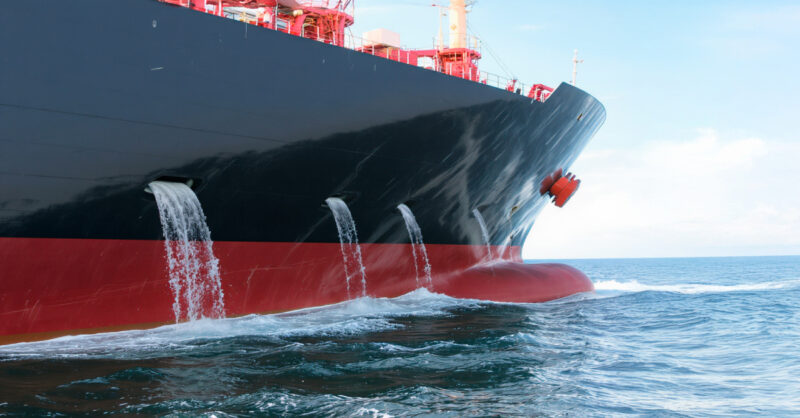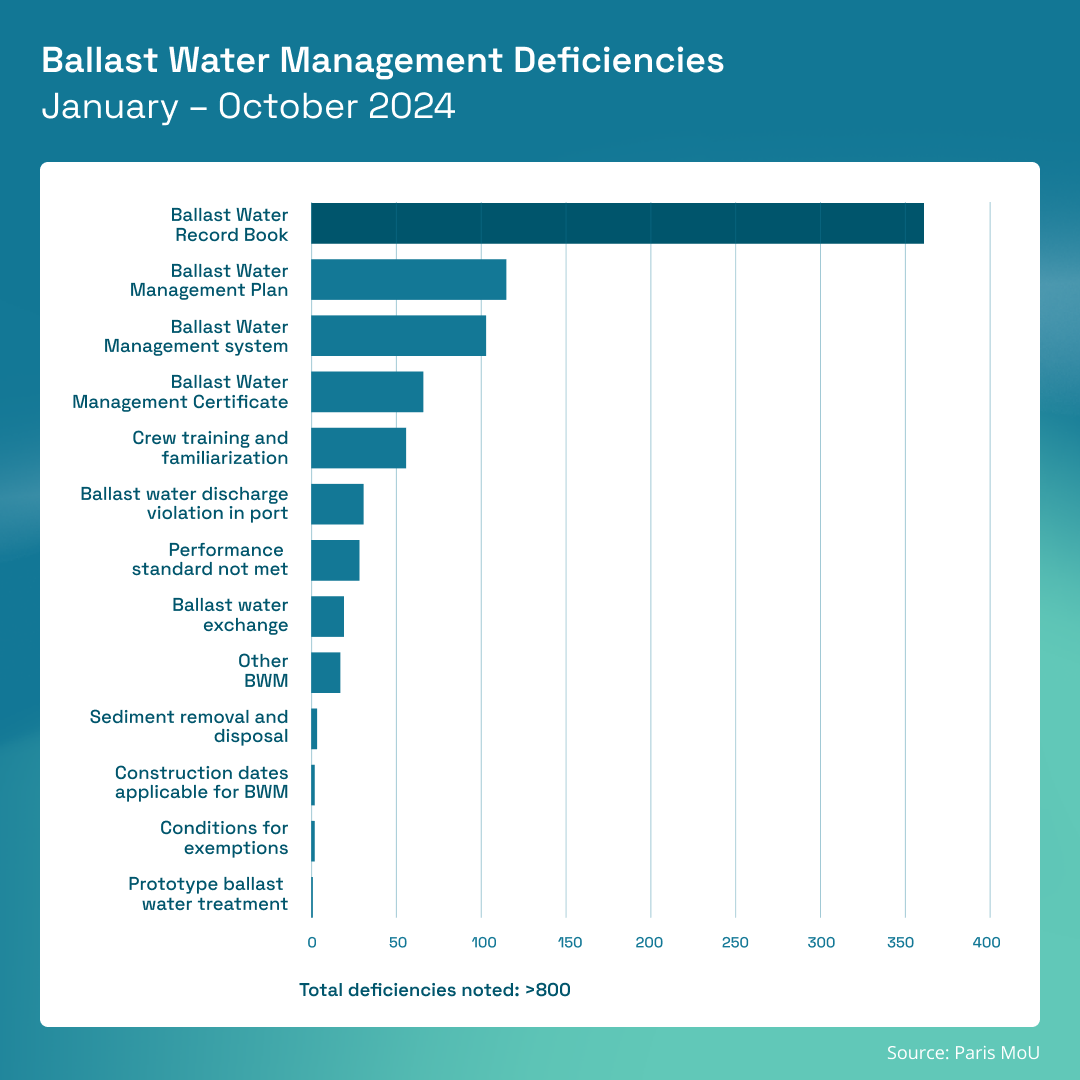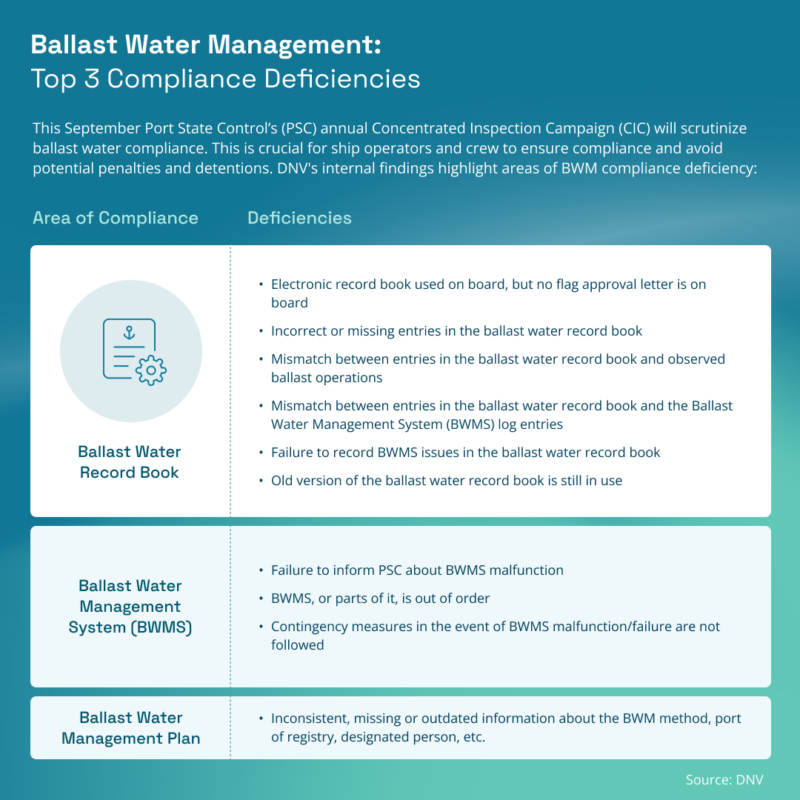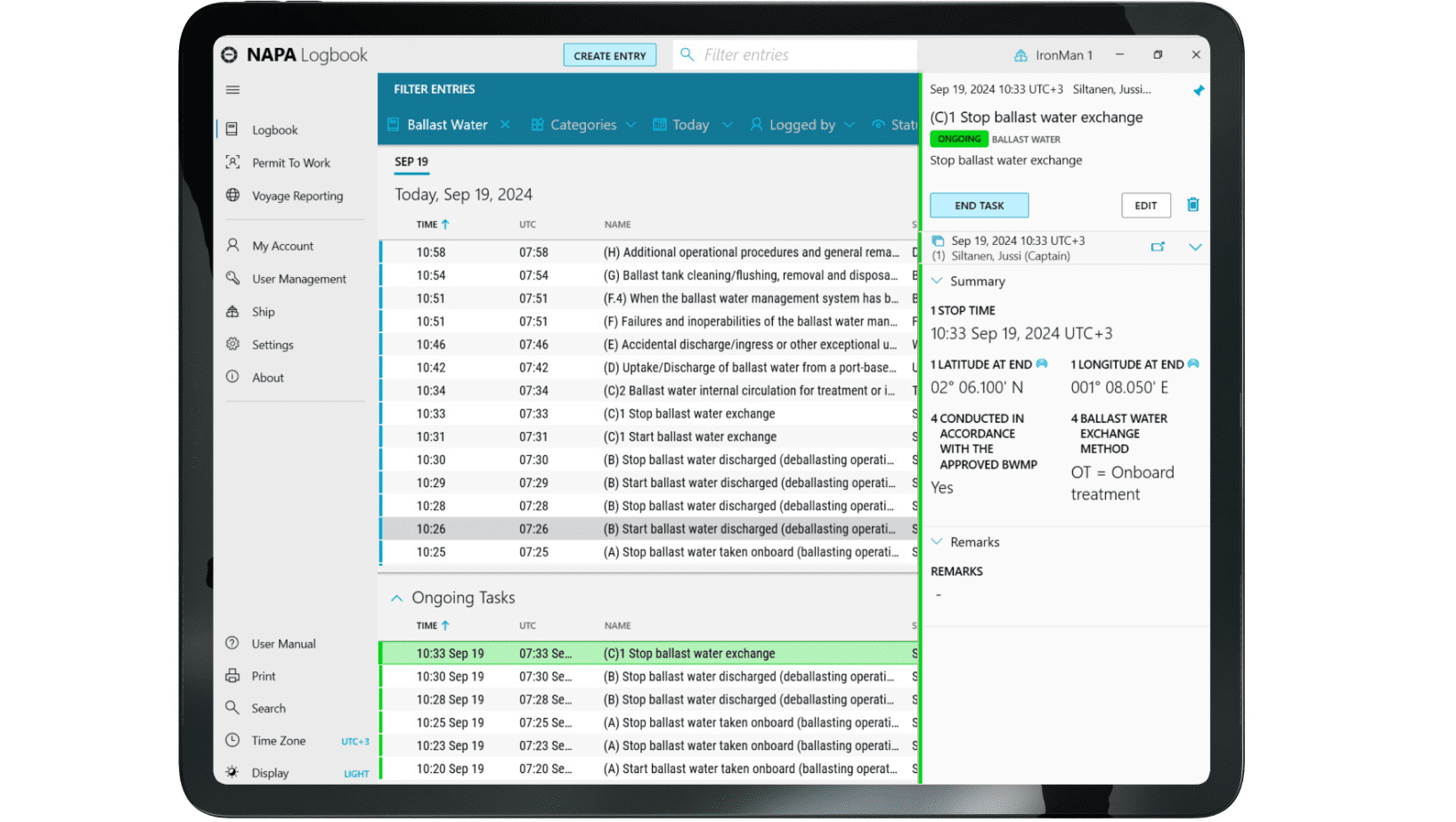August 12, 2025
Port State Control Inspections 2025: Ballast Water Compliance Under Scrutiny
When the Port State Control (PSC) rolls out its annual Concentrated Inspection Campaign (CIC) this September, it will be turning its full attention to ballast water compliance.

Concentrated inspection campaigns take place each year, targeting areas where the risk of non-compliance is high. This year, the CIC spotlight will fall on ballast water management. Between September 1 and November 30 2025, inspectors under the Paris and Tokyo Memoranda of Understanding (MoU), and likely beyond, will focus on ballast water record-keeping, system performance, and documentation consistency. During this period, you can expect questions from Port State Control when entering ports belonging to the 50 MoU administrations. Both your crews and ballast water management systems (BWMS) need to be ready.
If Port State Control officers identify deficiencies during the CIC, your vessel could be detained or fined.
On paper, this is another compliance check in the maritime calendar. In practice, it will act as a stress test for every vessel’s operational readiness and compliance culture, particularly as new regulatory expectations take effect, and industry-wide deficiencies persist.

Growing significance of Ballast Water Compliance
The scope of the 2025 CIC reflects a broader shift in the way maritime compliance is enforced. Where inspections once zeroed in on technical malfunctions, today’s PSC authorities are increasingly concerned with operational behaviour, documentation discipline, and crew awareness.
Ballast water record-keeping has emerged as one of the most significant areas of concern. According to data reported by the Paris MoU, 58% of non-compliance deficiencies in ballast water management are directly linked to poor record-keeping or administrative errors.
And the issue is not limited to clerical mistakes. In recent years, PSC inspections have flagged widespread inconsistencies between recorded entries and actual ballast operations, discrepancies between logbooks and onboard systems, and the use of outdated record book versions. DNV’s internal statistics from 2024 and early 2025 corroborate this trend, identifying record book mismatches, missing flag state approval letters for electronic systems, and unreported BWMS malfunctions as recurrent findings. As these gaps compound, so do the risks—for crews, for owners, and for the bottom line.

MEPC 82 and 83 add new layers
These inspections come at a time when regulatory complexity is expanding fast. The latest amendments to the Ballast Water Management Convention, approved at MEPC 82, coming into force as of February 2025, place renewed emphasis on the clarity, accuracy, and completeness of ballast water records. The updates require more detailed maintenance tracking, clearer documentation of contingency measures during system malfunctions, and verifiable crew familiarity with ballast water management protocols.
MEPC 83 has continued this trajectory by reinforcing data reporting requirements across the board, from GHG emissions to ballast water handling, and creating a compliance landscape where paperwork and performance are increasingly inseparable.
For shipowners and managers, this means more than operational diligence. It means rethinking the tools used to manage compliance and moving beyond fragmented or manual approaches.
Why the status quo is no longer enough
What makes this moment particularly challenging is the convergence of regulation, inspection pressure, and operational workload. Crews already shoulder the demands of voyage planning, safety management, emissions monitoring, and now an escalating volume of environmental compliance tasks.
In such an environment, the traditional record-keeping model—whether paper-based or isolated digital logs—is simply not fit for purpose. Even when electronic systems are in place, compliance failures still occur if those systems aren’t configured to current standards, connected to onboard data sources, or recognized by flag authorities.
A growing number of incidents, including detainable PSC findings, stem from preventable issues such as missing entries, outdated templates, and misaligned data between the logbook and the BWMS. And with the CIC sharpening its focus on these very vulnerabilities, the cost of inaction is no longer hypothetical.
Easing compliance with digitalization
Beyond the Checklist, the 2025 CIC questionnaire will drill into the root causes of recurring ballast water management deficiencies—covering not just system documentation and operability, but also crew proficiency. PSC officers will expect crews to demonstrate that they can run the BWMS as intended, from routine maintenance to implementing procedures for challenging water quality (CWQ) set out in the vessel’s Ballast Water Management Plan.
A BWMS alone won’t pass inspection. Both the system and the people operating it must be fully prepared if vessels are to avoid costly detentions or delays.
Amidst these challenges, leading operators are increasingly turning to integrated digital solutions that streamline and secure compliance processes, onboard and ashore.
The NAPA Logbook is one such platform gaining traction across the industry, particularly for ballast water record-keeping and other broader compliance schemes such as EU-MRV, EU-ETS, and IMO-DCS.

Rather than acting as a simple digital form, the system functions as a compliance engine. NAPA Logbook’s pre-configured templates align with the latest regulatory frameworks, ensuring crews record all required data points in a streamlined manner.. Connected to onboard systems, it can:
- Automatically populate relevant fields, minimizing the chance of human error.
- Input validation ensures that the data entered falls within expected ranges, flagging potential issues before they reach the audit stage.
- Importantly, the system also helps crews capture critical maintenance actions, log contingency operations in case of BWMS malfunction, and maintain full traceability with time-stamped entries and digital signatures.
This level of automation and standardization not only reduces administrative burden for crews but helps ensure that vessels are continuously inspection-ready, whether for a routine PSC check or a full-scale CIC audit.
Connecting ship and shore: the broader compliance ecosystem
The benefits of digitized record-keeping don’t end on board. Integrated with shoreside platforms like NAPA Fleet Intelligence, ballast water data becomes part of a wider compliance and performance ecosystem.
Logs are shared in real-time with technical managers and independent verifiers such as DNV’s Emission Connect. This eliminates the need for redundant data entry, reduces reporting cycles, and establishes a single source of truth that can be utilized for compliance documentation, emissions accounting, and informed strategic decision-making.
In this way, digital compliance tools are evolving from back-office utilities into core components of operational agility and business continuity.
Compliance, culture, and the future
The 2025 PSC CIC serves as a timely reminder that ballast water compliance is about fostering a culture of accountability and preparedness. As regulatory oversight deepens, modern systems that can keep pace must underpin that culture.
Shipowners who adopt digital compliance tools are not only future-proofing their operations. That said, they are also freeing up resources, reducing risk, and enabling their crews and managers to focus on what truly matters: operating safe, efficient, and environmentally responsible vessels.
